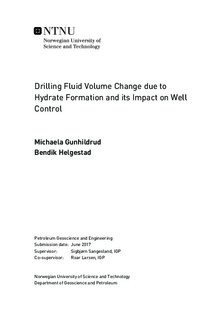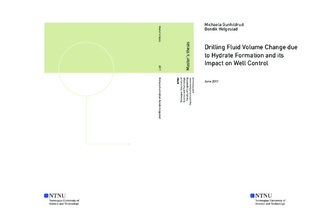| dc.description.abstract | Natural gas hydrates are crystal structures of water containing gas inside cavities. Hydrates can form if gas and water are present in a system with high pressure and low temperature conditions. Hydrate formation is considered a well control issue, and should be prevented.
Maintaining well control is crucial during drilling operations, and at least two barriers against the reservoir pressure are required. The drilling fluid column act as the primary barrier. A gas kick is a term used for the critical well control situation where a volume of gas enters the well. In case of a kick, the well should be shut-in and the kick circulated out. The kick is often detected by observing the mud level rising in the mud pit.
Hydrate formation inside the well after a gas kick will make the mud level reduce, as the hydrate volume in general is less than the separate volume of gas and water. Determining whether the change in mud level is a result of hydrate formation or loss of circulation can be challenging. The volume change due to hydrate formation is defined as the volume the mud column reduces with when gas and water form hydrates. If a kick with a volume of 4m3 enters the well, and all the gas are converted, the volume change will be 3.03m3 at a system pressure of 181 bar. This volume change will decrease the height of the mud column by 114 m, if drilling is performed with a 5'' drillpipe where a 9 5/8'' casing is used in the previous section.
20 hydrate formation experiments were performed at NTNU, where the objective was to observe which additives had an impact on hydrate formation, and the significance of the volume change and reduction when hydrates form. Tap water, Nidelv water, Fjord water, barite, bentonite, KCHOO, NaCl and CaCl2 was the different compounds used in the aqueous solution. The gas composition used was a mixture of 90% methane and 10% propane. The pressure cell was pressurized up to 24 bar and placed inside a refrigerator at 5C, for a period of approximately 24 hours.
Additionally, a hydrate formation experiment was conducted at the SINFEF multiphase flow laboratory at Tiller. A flow loop was filled with water and gas to observe hydrate formation, and the associated volume reduction in a high pressure system. The gas had a similar composition as a reservoir gas retrieved from the Barents Sea. In SINTEF Test 2 the system was initially pressurized to 181 bar, before cooling the system to 12C. The heating of the system started, when the system reached steady state at 104 bar after approximately 70 hours.
Hydrates were detected both visually and by pressure observations in both the NTNU experiments and SINTEF Test2. Analysis of the effect of the additives and water types in the NTNU experiment suggests that NaCl is the most efficient hydrate inhibitor. Furthermore, the analysis showed that both the amount of surface area available in the aqueous solution and an increase in viscosity seems to act favourable in terms of hydrate formation speed, and that an increase in viscosity might impact the hydrate growth rate. Hydrate formation stops before reaching hydrate equilibrium in most of the NTNU experiments and in SINTEF Test 2, at a pressure of approximately 18 bar and 104 bar respectively. The hydrate formation possibly stopped because the hydrates created a physical boundary between the gas and aqueous phase, which prevented further growth.
The volume reduction for the NTNU experiments is in the range between 92.7% and 96.3%, when 95% of the large and 50% of the small cavities are assumed to be filled in the hydrate crystal structure. In the SINTEF Test 2, the volume reduction is 76.1% when considering the same number of filled cavities. When the system pressure increases, the volume reduction reduces.
Finally, the temperatures after shut-in in a well located in the Barents Sea has been considered in order to find the well interval where hydrates can form at various times after shut-in. The amount of inhibitor needed to prevent hydrate formation has also been calculated. Depending on the mud density, hydrate formation could start between 900 m to 1250 m below the seabed in the Barents Sea well. To inhibit hydrate formation in such a scenario, between 14.2wt% and 18.0wt% Nacl or 16.7wt% and 22.0wt% CaCl2 have to be added to the water phase of the aqueous solution. | |

